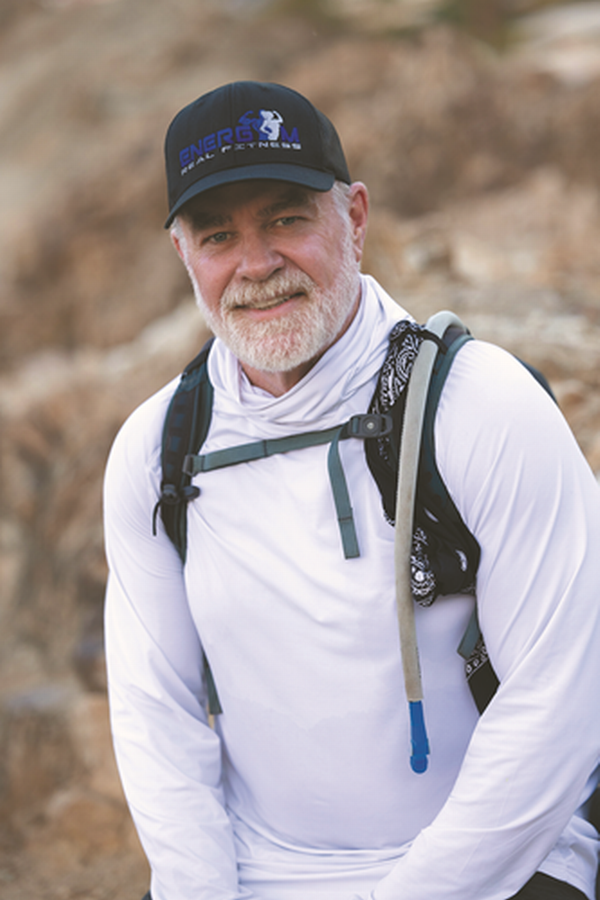Unexpected Challenges

He had recently returned home from a 20,000-foot climb in Ecuador when, one night in May 2024, he was awakened by severe abdominal pain, nausea and vomiting.
“I thought that maybe it was food poisoning,” he says. But the pain refused to go away. His wife, Melinda, called an ambulance, which took him to the Tennity Emergency Department at Eisenhower Health. A scan diagnosed a large kidney stone, but in the
process, doctors discovered Larson faced a different kind of danger, one that if left untreated, could prove deadly.
“I was told in the ER that I had this massive murmur, but I kind of poo-pooed it,” Larson says. “I thought, ‘I’m fine. I just got back from a 20,000-foot climb.’ But the ER doctor chased after me in the parking lot and said, ‘You need to see your cardiologist.’” He adds, “If not for him being persistent ... ,” his voice trailing off.
“Being in medicine, I shouldn’t have done that,” admits Larson. “But once I had the echocardiogram, I thought, ‘Wow, I’m a pretty lucky guy.’”
That echocardiogram revealed the seriousness of Larson’s condition: severe aortic valve stenosis, a life-threatening situation that required surgery. A referral sent him to Daniel Logsdon, MD, a Board Certified Cardiothoracic Surgeon with the Eisenhower Cardiothoracic Surgery Specialty Clinic in Rancho Mirage. The clinic is renowned for providing state-ofthe-art care for patients requiring surgical treatment for cardiac and lung disease.
On July 8, 2024, Dr. Logsdon replaced Larson’s valve through minimally invasive surgery. It took a little more than two hours for Dr. Logsdon to make a “very small incision, stop the heart, cut out the old valve and put in the bovine pericardium [a double-layered membrane from cows used for heart valves and vascular patches in cardiovascular procedures].” Thanks to the technique, patients typically go home in three days.
Bicuspid aortic valve stenosis is a congenital condition affecting about 2% of the population. Instead of three leaflets through which blood pumps from the heart to the aorta, the bicuspid valve only has two, affecting efficient blood flow.
“Over time, calcification buildup further restricts the flow, essentially, shutting ’er down,” says Larson.
With a bicuspid aortic valve, “usually you hear a murmur,” Dr. Logsdon says, which means patients in such cases should get an echocardiogram and be evaluated by a cardiologist for further treatment.
“With stenosis, the aortic valve narrows so that blood can’t exit,” he says. “Symptoms include shortness of breath, fatigue and dizziness. Dizziness can cause one to potentially pass out because the blood can’t get out of the valve,” he continues.
“Usually, it’s a very quick thing. Stress builds, then everything can happen.”
Larson’s fitness as a high-altitude climber, combined with his strenuous workout routine, likely sustained him long enough 
“Mike is a very healthy, active individual, but he was beginning to have limitations on his activities,” notes Dr. Logsdon. “I think he was so well-trained that his heart was trained to work under the stress, up until the point of surgery.” Without intervention, “the heart eventually just fails,” he admits.
In a matter of months, Larson had gone from the mountaintop to fighting for his life.
“The kidney stone was divine intervention or something,” he relates. “If it wasn’t for the kidney stone, I never would have known.”
Today, more than a year post-surgery, Larson has an excellent prognosis, notes Dr. Logsdon. Every year he is to follow up with his cardiologist for an echocardiogram to check up on the valve. He takes low-dose aspirin once a day.
As for Larson, “It’s been really good,” he says proudly. Post-operation, he spent the first week on bed rest and then was given permission to walk around the neighborhood, which he describes as “flat.”
“Then I got really bored,” he says. “The mountain was pulling me back. I thought, ‘I’ll go to my gym and do the (stair-climbing machine).’ It felt comfortable. Then I felt a tap on my shoulder. I turned around and it was Dr. Logsdon.”
Larson says his surgeon told him to go home and see him in a week, and then they’d talk. His recuperation began in earnest afterward, and he was back hiking, with permission, about eight weeks after surgery. He was careful to use hiking poles to avoid falling. Larson has no limitations these days, which see him training for the next summit. Prior to surgery he had completed 13 of the 58 14,000-foot peaks in Colorado.
“I hope to knock off the rest of those,” he quips.
The man who has done five climbs above 18,000—19,000 feet and has climbed Mount Kilimanjaro is back to the high-intensity interval training (HIIT) routine developed by his gym owners to prepare him for what’s next.
“The rest is getting out there and hiking,” he relates.
Mike and Melinda, his wife of 35 years, are the parents of two grown daughters. They have even more to look forward to these days: their first grandchild, a boy. And while Larson’s mountain “hobby” may take him to new heights, his goal remains the same.
“I promise my wife I’ll get back,” he notes. “The goal is not to get to the top, it’s to get home safely.”
To learn more about the services at Eisenhower Desert Cardiology Center,
visit Heart.EisenhowerHealth.org.



